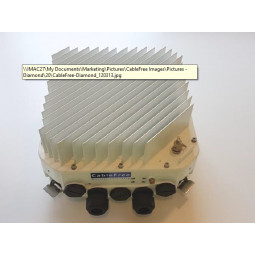CF-Microwave-Radio CableFree Diamond - High Capacity Full Outdoor Microwave Radio
- Compact, All-Outdoor High Power Configuration
- Spectrally Efficient, Software-Defined 2048QAM Radio
- Dual-Core/Dual Carrier Microwave with XPIC (Cross Polar Interference Cancellation) Technology
- Powerful Forward Error Correction (FEC)
- Adaptive Coding & Modulation (ACM), Adaptive Power Control (APC)
- Capacity up to 2Gbps Full Duplex (stacks to 4Gbps+)
- Native IP/Gigabit Ethernet POE & SFP Interfaces
- Rugged & proven telecom-grade design
- 1+0, 1+1, 2+0, Dual 1+0, & 4+0 configurations
- Rapid Spanning Tree (RSTP), QinQ, Jumbo Frame (9600 byte) support, Sync-E Synchronisation
- Licensed & Unlicensed (17, 24GHz) band supported
Enhanced Performance, Flexibility & Features
CableFree Diamond Microwave radios are high performance, modern generation wireless networking platforms supporting IP/Ethernet interfaces, operating in licesed and unlicensed frequency bands and capacities up to 2Gbps (or 4Gbps using dual radio) or even higher aggregation.
CableFree has pioneered the use of Software-Defined Radio, which enables in-service upgrades, remote configuration, low equipment costs. Advanced features such as Adaptive Coding and Modulation (ACM) ensure maximum uptime for ISPs and other customers who have to offer SLA’s based on uptime, or are limited on antenna size for difficult sites.
Advanced carrier-centric features such as Rapid Spanning Tree are included, as well as Synchronisation features such as Synchronous Ethernet (SyncE). QoS and QinQ VLAN features are standard.
Operating distances vary depending on local weather conditions, specifically link frequency and rain intensity. Planning for microwave wave spectrum use must take into account the propagation characteristics of radio signals at this frequency range. CableFree has a complete range of tools and services available to plan your microwave network to meet all design objectives. Generally, higher frequencies are used for short-range, high capacity links, and lower frequencies are used for long range links. Link lengths exceeding 100km are possible when correctly designed, specified and deployed.

